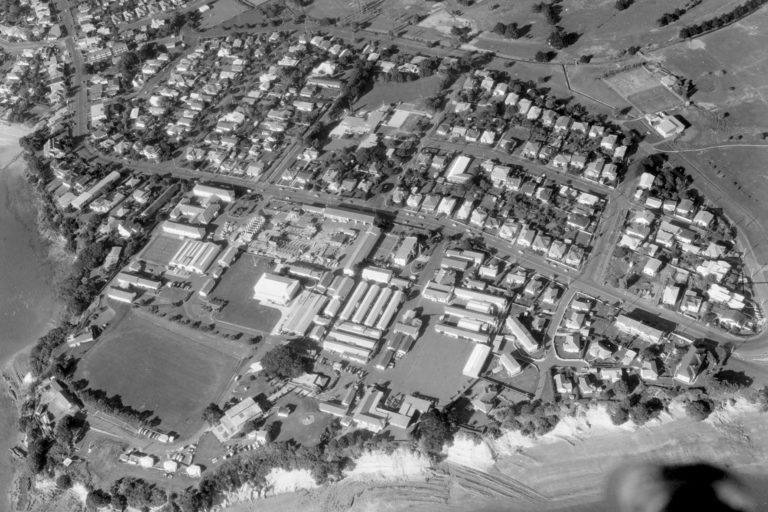History of Fort Takapuna
The Royal New Zealand Navy’s real association with Narrow Neck dates from 1963, when the Training establishment, HMNZS Tamaki, moved into some surplus Army space.
At that time there was still a strong army presence, in fact during the flag raising ceremony on 26 September, of what was to become the Administration Block, just inside the main entrance, was still divided into flats and the slightly bemused residents watched the ceremony from their windows.
It was, however, a naval threat that caused this fort to be constructed. It was part of a series of defences erected at the main ports, to defend them against a possible raid by an enemy cruiser.
The result of such a raid was highlighted in a report published in The New Zealander, the major newspaper of the day, when it reported that Auckland had been shelled by a Russian cruiser, much damage had been done to the business district and Russian sailors had landed and looted shops.
In those days before the telephone and mass communications, this report caused considerable alarm and many thought the Empire would go to war.
That is until the phonetics of the name of the Russian ship were realised – it read “Case of Whisky”.
The Navy first came to Fort Takapuna in 1927. By that time the fort was obsolete and not required by the Army.
It was used to house ammunition for cruisers. Previously it had been stored at Mount Victoria and then North Head, but by then the storage of explosives at Mount Victoria was considered unacceptable by both the Defence Department and the residents, and the North Head magazines were required by the Army.
In addition to actually storing the explosives, there was a requirement to test various parts of the ammunition, and a proofing building was constructed alongside (under the Morton Bay Fig Tree).
As had been experienced from the first days of the fort, there were several drawbacks to using this facility. It is readily prone to flooding – even with the best of maintenance.
It was with much rejoicing that in 1936, the Navy moved its explosives to a new, purpose-built facility in a sparsely populated area of the North Shore – Kauri Point.
While the Navy moved, the Army remained.
During the Second World War there was much activity in the area surrounding the fort and over on the southern side of the playing field, a monitoring station for the fixed anti-submarine defences of Auckland – Station Puna – was built.
With the end of the war, the Navy again vacated the area returning in 1963.
At that time the old quarantine station on Motuihe Island, which had been built around the turn of the century was in urgent need of serious maintenance and rebuilding. With all factors taken into consideration, it was decided that Navy would share the surrounding facilities with the Army.
Although there were periodic conflicts of interest, the relationship was generally satisfactory. With periodic reorganisations of the Army, its presence was gradually reduced, until at last only the Officers’ mess remained an Army facility, although run entirely by the Navy.
For most of the time the fort itself was locked up, but for a short time it was used as a recreation space for some of the senior trainees.
Over the years there were several efforts to vest ownership of this fort to the local authority, but for a variety of reasons, this was not possible until 2000.











